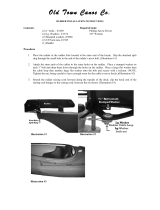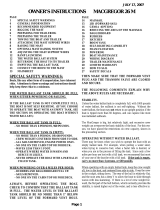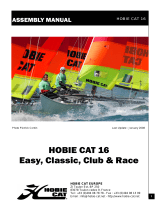Page is loading ...

Hobie Getaway
Assembly Manual


In 1950, Hobie’s dream was born in his parents’
garage when he decided to apply his love of
woodworking to the sport of surfing. Dad
backed out the Buick... Hobie carved out his
very first surfboard...
Hobie’s business of fun had begun.

4
hobie.com
Table of Contents
Getaway terminology ...................................................................................................................................... .5
Anatomy ...............................................................................................................................................................6
Hull Assembly ......................................................................................................................................................8
Trampolines ........................................................................................................................................................ .9
Main and Jib Sheet ........................................................................................................................................ .13
Righting Line ......................................................................................................................................................14
Mast ......................................................................................................................................................................15
Mast .....................................................................................................................................................................19
Mainsheet ......................................................................................................................................................... .20
Sail ..........................................................................................................................................................................20
Rudder ................................................................................................................................................................. .25
Tiller Crossbar ..................................................................................................................................................27
Sailing Basics .....................................................................................................................................................28
Sailing your Getaway .................................................................................................................................... .32
Storage and Transport ................................................................................................................................ .34
Maintenance and Care .................................................................................................................................37
Look for this icon. Online video is available at
www.hobiecat.com/support/products
Please read through the instruction manual before using this product
Setting Up Your Getaway
Assembly Required
Rigging for Sailing
Other Information

5
hobie.com
Getaway Terminology
Mast Float
Forestay
Battens
Shroud
Mast
Sail Clew
Main Sheet System
Tiller Arm
Rudderhead
Rudder
Downhaul
Forestay /
Bridle Adjuster
Bridle
Hull
Sail

6
hobie.com
Anatomy
1. (1) Mast float
2. (2) Rudder assemblies
3. (2) Mast pieces
4. (1) Rear crossbar
5. (1) Tiller cross bar, Tramp rods
6. (1) Front cross bar (Spreader)
7. (2) Hulls with hardware bag
8. (1) Forestay assembly with jib and
9. (1) Main cross bar (Mid) with Trampolines
10. (1) Jib
11. (1) Main Sail
(1) Box of small parts
Large Components
1
2
3
4
5
6
7
8
9
11
10

7
hobie.com
Anatomy
1. Mainsheet system
2. Downhaul line
3. Righting line
4. Shroud wires
5. Main halyard line
6. Trampoline lace lines
Small Parts
1
2
3
4
5
6

8
hobie.com
Assembly Required
Knots to Use
Figure 8 Knot Bowline Knot Halyard Knot Cleating off a Line
1
Lay the hulls on the ground with inside of hulls facing up, about seven
feet apart. Insert the crossbars into one hull. You will have to remove
the pre-installed botls from the ends of the forward crossbar before
instaling into the hulls. See that the crossbars seat fully into their
sockets in the hull. Slide the other hull onto the crossbars until the
hulls come in contact with the stop plates (located on the underside of
the main and aft crossbars).
Hull Assembly
Be sure the forward
spreader is fully seated
in both hulls. Re-Install
the screws into each end
from the outside of the
hull. Do not over tighten
or compress the plastic
hull material.

9
hobie.com
Assembly Required
Trampolines Installation
1
Unroll the trampolines from the main crossbar. Slide the main
trampoline bolt ropes into the hull trampoline tracks. Soapy water
can be used as a lubricant (Do not use an oil or silicon lubricant on the
trampoline track or the bolt rope). Sliding the bolt rope into the track
is a 2 person job. One person should pull the trampoline and the other
feed the bolt rope into the track.
2
After both main trampoline halves
are in place, but not laced, install
the forward trampoline following
the same techniques as with the
main. Except, because the
forward trampoline is one piece,
it is necessary to alternate from
side to side while feeling it into the
tracks. Feed the trampoline
equally on both sides.

10
hobie.com
Assembly Required
Lace Forward Trampoline
Slide the lace rod into the forward trampoline pockets. Tie the laceline
to the eyelet. Pass the line through the grommet in the trampoline.
1
Pass the line back
through the eyelet, then
over to the first slide
and to the first cutout
and around the rod and
back to the slide. Con-
tinue this to each slide
and cutout across the
tramp as shown. Tighten
the lines once it is all
laced.
2

11
hobie.com
Assembly Required
Lace Main Trampoline
Using the center trampoline lacing line, lace the center of the trampo-
lines together per the diagram below. Start at the front of the trampo-
line by tying a bowline knot to the grommet and work your way back.
Once you lace the line all the way through, go back to the front of the
trampoline and pull tension on the line to make sure the trampoline is
tight.
Slide the lacing
rod through the
back pocket on
the trampoline.
1
2
1
2
3
4
5
6...

12
hobie.com
Assembly Required
Using a bowline knot, tie the
rear tramp lacing lines to the
grommets in the rear corner
of each trampoline.
Route the line underneath the rear
crossbar and lace it around the eyelet
posts on the back of the bar as shown
in the diagram. Make sure to pull ten-
sion on the line to pull the trampoline
tight. When you lace the line all the
way to the center of the trampoline,
tie off the end of the line. Follow this
procedure for both sides of the rear
trampoline.
3
4
1
2
3
4
5
6
7

13
hobie.com
Assembly Required
Main/Jib Sheet Installation
Jib
Main
Route the jib sheet through
the cleats on the main
crossbar. Feed the end of
the jib sheet line through the
block attached to the jib clew.
Attach the mainsheet to the traveler
car by passing the clevis pin through
the shackle on the mainsheet block,
holding it in place with the clevis pin.
Route the mainsheet line through the
traveler cleat on the rear crossbar,
then the traveler car, and through the
padeye on the rear of the beam. Tie a
knot at the end of the line to hold it to
the crossbar.
Run the jib sheet ends back to the
main crossbar, through the eyelits
and tie a figure 8 knot on the back
side of the eyelits.

14
hobie.com
Righting Line Installation
Thread one end of the line
through a grommet located at
the rear of the trampoline from
the bottom going upwards. Tie
a figure 8 at the end of the line
on the top of the trampoline
with the righting line below.
Pass the line around the inside
perimeter of the trampoline
through the stainless rings
attached to the main crossbar,
and then back to and up
through the grommet on the
opposite side.
1
2
Assembly Required

15
hobie.com
Assembly Required
Install the mast float to the upper mast section as shown. Place a few
drops of Loctite on the bolts before screwing them in to ensure the
mast float stays attached. Be sure the blunt end of the float is fac-
ing forward towards blunt side of the mast. You may have to loosen
the bracket bolts that pass through the mast head to get the screws
aligned in the float.
1
Mast Float Assembly
WARNING
The lower section of the mast is aluminum and
displays warnings against assembling and sailing
near overhead wires and power lines. The upper
section is fiberglass and is designed to help prevent
injury that can occur if the mast does contact a high
power line. Before raising the mast, check that you
are in a safe area and always remember this warning.

16
hobie.com
Assembly Required
Mast Assembly
To step the mast
upright, position the
mast base next to the
mast step ball. The mast
top and float should be
positioned to the rear
of the boat in the center
of the rear crossbar.
Once you place the mast
on the ball install the
stepper bolt and thread
on the nut. Make sure to
line up the yellow arrow
on the main crossbar
with the arrow on the
mast of the mast.
1
Place the thimble of the
shroud between the adjuster
plate and insert a clevis pin
through the plate and
thimble. Then fasten with the
ring.
Using a clevis pin and ring,
connect the adjuster plate to
the shroud mounting plate on
the hull. Pull the rubber boot
cover down over the top of the
shroud attachment assembly.
2
3

17
hobie.com
Assembly Required
Starboard Shroud
Port Shroud
Forestay/Jib Halyard Assembly
Using the large shackle provided, from
the small parts box, attach the shroud
and forestay wire to the mast tang.
Make sure the forestay/jib halyard
assembly is between the shroud and
that the wires aren’t twisting around
each other.
4
Wrap the shackle safety
wire through the hole in
the shackle and around
the shackle itself.
5

18
hobie.com
Insert the forestay adjuster into the furler drum one or two holes and
pin in place. Check and tension the shackle at the lower forestay to
adjust connection. Tension fully with pliers or vice grips.
6
Assembly Required

19
hobie.com
Lifting from the back
of the mast, raise the
mast into the upright
position. Be sure to
keep the arrows at the
mast base and front
crossbar aligned. Walk
forward while lifting
the mast until the side
shrouds go tight
preventing the mast
from further forward
movement.
Insert the forestay adjuster
into the furler drum one
or two holes and pin in
place. Check and tension
the shackle at the lower
forestay to adjuster
connection. Tension fully
with pliers or vise grips.
2
3
Rigging
Install the mast on the mast ball located on
the front crossbar and install the stepper pin.
1
Raising Mast

20
hobie.com
Rigging
Sail Assembly
Mainsheet Cleat Angle Adjustment
Hollowed-out
side of tip
Start here with a
bowline knot
Batten pocket
Clean at mouth of each tip
The lines are threaded through each batten end cap but are not
tensioned. To tension the battens, pull tension on the line forcing the
batten into the pocket and cleat it. Tie a small figure 8 knot in the end
of each line to prevent the battens from falling from the sail if the line
releases from the cleat.
Turn the screws on each side of
the cleat counterclockwise 1-2
turns. DO NOT COMPLETELY
UNSCREW.
1
1
Adjust the cleat angle to your
preference and tighten the
screws to hold in place.
2
/





